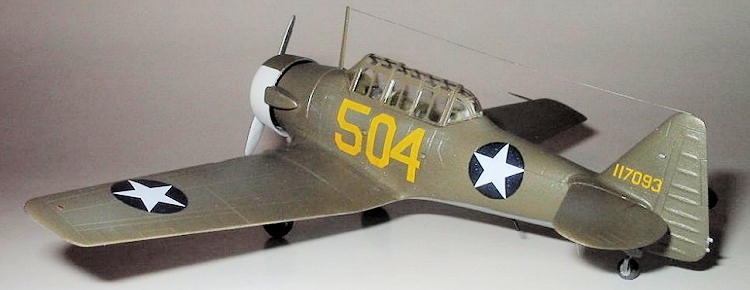
| KIT #: | 80233 |
| PRICE: | $9.95 MSRP |
| DECALS: | Two options |
| REVIEWER: | Brian Baker |
| NOTES: |

| HISTORY |
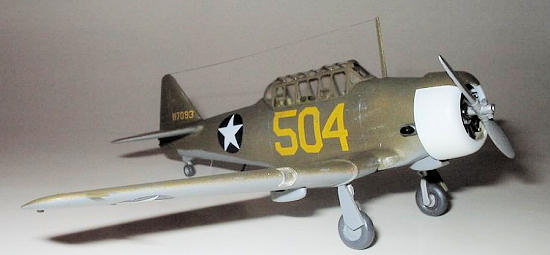 rcraft.
rcraft.
There is
a lot of material available on the T-6 series. The
Squadron ďIn-ActionĒ # 94 gives a good
account of the planeís development, along with some color.
The best source Iíve found is the new book
ďNorth Americanís T-6Ē
by Daniel Hagedorn, an epic study of the plane well worth having in any serious
modelerís collection. The old
Profile series had coverage, and there is a lot of material available on line.
You could build a hundred models of T-6ís and never duplicate a single one.
 The kit
depicts two postwar T-6Gís; one
is a Korean War 1952 aircraft of the
6147 TCS, at Seoul in 1952,and the other is a Chicom aircraft, probably an
earlier model taken over from the Nationalists in the late forties, although how
they would have gotten a T-6G at that time is open to question.
Maybe it was flown over later from
The kit
depicts two postwar T-6Gís; one
is a Korean War 1952 aircraft of the
6147 TCS, at Seoul in 1952,and the other is a Chicom aircraft, probably an
earlier model taken over from the Nationalists in the late forties, although how
they would have gotten a T-6G at that time is open to question.
Maybe it was flown over later from
Any kit of the AT-6/SNJ/Harvard can be used to depict any of the variants starting with BC-1A, At-6A, SNJ-2, and on up to the late model types. There are some differences in canopy form, rudder, propeller, and avionics carried, but they are all structurally similar, and should present no serious problems to the serious modeler. The fabric covered fuselage models would be a little more difficult, but are several Wirraway kits available, as well as the old Airfix Boomerang if youíre really inclined in that direction. And the old Hawk kit has its possibilities, as I converted one into the NA-16 prototype a few years ago.
| THE KIT |
The hobby
Boss Kit is the latest in a series of 1/72 scale kits of the T-6 that have
appeared over the years. In the
late fifties, Hawk produced a rather rudimentary but reasonably accurate model
of the T-6G/SNJ series, complete with embossed insignia and little interior or
wheel well detail. In fact, the drawings issued with the kit were actually first
prepared by North American. Airfix
followed later with a kit depicting the British Harvard, and this was an
improvement in some ways, but it still lacked detail.
Hellerís kit, introduced in the eighties, was much better, and Academyís
offering about 10 years ago seemed to complete the array.
And now, Hobby Boss entered the picture. Their kit is copyrighted 2007.
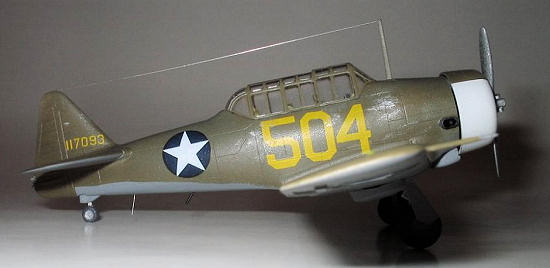 The Hobby
Boss kit consists of 31 parts, including a canopy and two landing light covers.
It follows the usual pattern of a major wing assembly, a fuselage
assembly, a forward cowling and wheel well assembly, an engine and cowling
assembly, and the usual tail unit, landing gear, and, antenna. There is very
little flash, but some mold lines need to be removed, and some filler is
required, especially around the forward wheel wells, which lack any kind of
detail. The floor and two nicely
done seats constitute the interior, and there are no sticks or instrument
panels. The fabric detail is a
little overdone, consistent with all 1/72 scale Hobby Boss kits.
The Hobby
Boss kit consists of 31 parts, including a canopy and two landing light covers.
It follows the usual pattern of a major wing assembly, a fuselage
assembly, a forward cowling and wheel well assembly, an engine and cowling
assembly, and the usual tail unit, landing gear, and, antenna. There is very
little flash, but some mold lines need to be removed, and some filler is
required, especially around the forward wheel wells, which lack any kind of
detail. The floor and two nicely
done seats constitute the interior, and there are no sticks or instrument
panels. The fabric detail is a
little overdone, consistent with all 1/72 scale Hobby Boss kits.
The kit
suffers from the usual Hobby Boss lack of real detail.
The engine cowling looks slightly too large, or maybe it is the forward
fuselage that is too narrow. The engine is abstract, and the cylinders look
toy-like. There is no ignition
harness ring in front like all respectable R-1340ís had.
Two DF loop antennas are provided, and the drawings show a short mast
BEHIND the 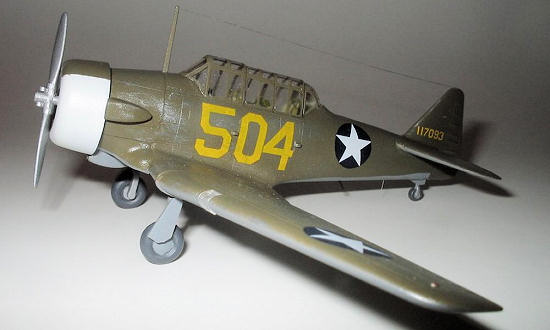 loop,
something Iíve never seen on a T-6G.
The prop can be trimmed down, with the round counterbalances added on the
hub. The tailwheel juts forward if
you press it all the way in, but if you donítí it looks a lot better. The gear
doors are incorrect in shape, and the wing underside lacks correctly shaped
aileron hinges. The horizontal stabilizers attach to the rear fuselage with a
large gap that is difficult to eliminate.
And quite a bit of filler is required in the forward fuselage area, not
to mention where the wing dihedral was corrected. A good set of three views is
essential for building this kit.
loop,
something Iíve never seen on a T-6G.
The prop can be trimmed down, with the round counterbalances added on the
hub. The tailwheel juts forward if
you press it all the way in, but if you donítí it looks a lot better. The gear
doors are incorrect in shape, and the wing underside lacks correctly shaped
aileron hinges. The horizontal stabilizers attach to the rear fuselage with a
large gap that is difficult to eliminate.
And quite a bit of filler is required in the forward fuselage area, not
to mention where the wing dihedral was corrected. A good set of three views is
essential for building this kit.
The interior is sparse, but can be improved. I added some sidewall detail, and also made some instrument panels to install. Control sticks were also made, but these are almost invisible through the thick canopy. However, with some work, an acceptable model can be made. This kit is not hopeless; it is just one that requires a lot of work to correct the errors. For a look at the sprues, check out the preview done earlier this year.
| CONSTRUCTION |
The
assembly process itself is a snap.
The parts can almost be thrown together from the other side of the room, as is
common with Hobby Boss kits.
I liked the scoops on the fuselage, as they were well designed. Some filling is
needed, but the overall result is something that looks a lot like an AT-6.
I added some interior details, but left things pretty much as they were,
except, of 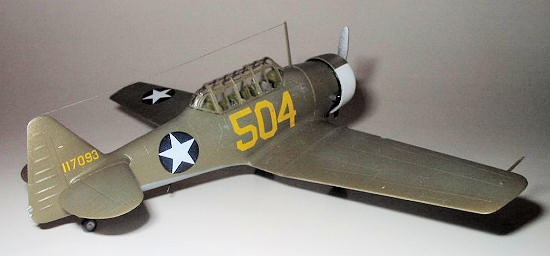 course,
for the wing. On this particular aircraft, the photo shows
a small fairing underneath the right wing, similar to a shell ejector
case on the Monogram P-36C model.
Thatís what I used. I also added a radio mast ahead of the cockpit, which was
standard on this model.
course,
for the wing. On this particular aircraft, the photo shows
a small fairing underneath the right wing, similar to a shell ejector
case on the Monogram P-36C model.
Thatís what I used. I also added a radio mast ahead of the cockpit, which was
standard on this model.
| COLORS & MARKINGS |
I decided
to do an early World War II aircraft, from a photo provided by Dana Bell.
It is an AT-6B-NT, AF 41-17093, Coded
#504, which was operated by the 2nd Aerial Gunnery Training
Group, Laredo Army Air Field,
| CONCLUSIONS |
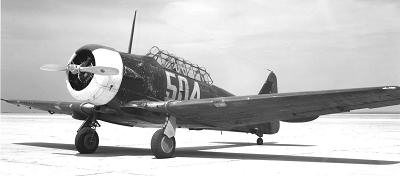
July 2009
If you would like your product reviewed fairly and quickly, please contact me or see other details in the Note to Contributors.